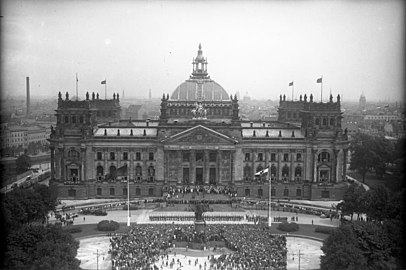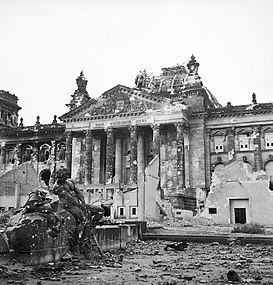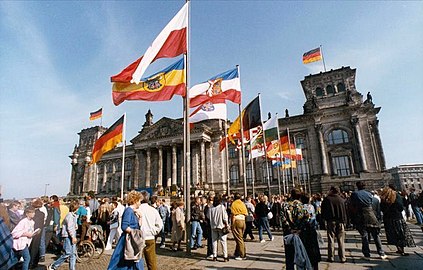Reichstag building: Difference between revisions
Undid revision 1150839698 by 2603:7080:9207:AD00:6447:FFBB:1672:8036 (talk) objective foto |
|||
| Line 89: | Line 89: | ||
<gallery mode="packed" heights="190"> |
<gallery mode="packed" heights="190"> |
||
File:Reichstagsbrand.jpg|The [[Reichstag fire|Reichstag building on fire]], 27 February 1933 |
File:Reichstagsbrand.jpg|The [[Reichstag fire|Reichstag building on fire]], 27 February 1933 |
||
File: |
File:Berlin Reichstag2.jpg|''Raising a Flag over the Reichstag'', by [[Yevgeny Khaldei]], 2 May 1945 |
||
File:Ruins of the Reichstag in Berlin, 3 June 1945. BU8573.jpg|Ruins of the Reichstag building in [[Allied-occupied Germany|postwar occupied]] Berlin, 3 June 1945 |
File:Ruins of the Reichstag in Berlin, 3 June 1945. BU8573.jpg|Ruins of the Reichstag building in [[Allied-occupied Germany|postwar occupied]] Berlin, 3 June 1945 |
||
</gallery> |
</gallery> |
||
Revision as of 14:44, 20 April 2023
| Reichstag | |
|---|---|
 The dedication Dem deutschen Volke, meaning To the German people, can be seen on the frieze. | |
 | |
| General information | |
| Address | Platz der Republik 1, 11011 Berlin |
| Town or city | Berlin |
| Country | Germany |
| Coordinates | 52°31′07″N 13°22′34″E / 52.51861°N 13.37611°E |
| Current tenants | Bundestag |
| Construction started | 9 June 1884 |
| Completed | 1894 |
| Renovated | 1961–1964, 1992–1999 |
| Height | 47 m (154 ft) |
| Technical details | |
| Floor count | 6 |
| Floor area | 61,166 m2 (658,390 sq ft)[1] |
| Design and construction | |
| Architect(s) | Paul Wallot |
| Renovating team | |
| Architect(s) | Norman Foster |
The Reichstag (German: Reichstag, pronounced [ˈʁaɪçsˌtaːk] ; officially: Plenarbereich Reichstagsgebäude [ˈʁaɪçstaːksɡəˌbɔʏdə] ; English: Parliament) is a historic government building on Platz der Republik in Berlin that has been the seat of the German Bundestag since 1999. Since 1994, the Federal Convention has also met here to elect the Federal President.
The Neo-Renaissance building was built between 1884 and 1894 in the Tiergarten district on the left bank of the River Spree to plans by the architect Paul Wallot. It housed both the Reichstag of the German Empire and the Reichstag of the Weimar Republic. Initially, the Reich's Federal Council also met there. After severe damage in the Reichstag fire of 1933 and during the Second World War, the building was modernised and restored in the 1960s and used for exhibitions and special events. From 1995 to 1999, the Reichstag was fundamentally redesigned by Norman Foster for its permanent use as a parliament building, which was decided in 1991. The keys were handed over to the President of the Bundestag, Wolfgang Thierse, on 19 April 1999. The Bundestag has been meeting there ever since. A landmark of the city is the walk-in glass dome above the plenary chamber, designed by Gottfried Böhm.
Etymology
The term Reichstag, when used to connote a diet, dates back to the Holy Roman Empire. The building was built for the Diet of the German Empire, which was succeeded by the Reichstag of the Weimar Republic. The latter would become the Reichstag of Nazi Germany, which left the building (and ceased to act as a parliament) after the 1933 fire and never returned, using the Kroll Opera House instead; the term Reichstag has not been used by German parliaments since World War II. In today's usage, the word Reichstag (Imperial Diet) refers mainly to the building, while Bundestag (Federal Diet) refers to the institution.
History of the building
Imperial and Weimar Republic eras
Construction of the building began well after the unification of Germany in 1871. Starting in 1871, and for the next 23 years, the parliament met in the former property of the Königliche Porzellan-Manufaktur Berlin, at Leipziger Straße 4. In 1872 an architectural contest with 103 participating architects was carried out to erect a new building, a contest won by Ludwig Bohnstedt. The plan incorporated the Königsplatz (today's Platz der Republik), which was then occupied by the palace of a Polish-Prussian aristocrat, Athanasius Raczyński. Unfortunately, that property was unavailable at the time.[2]
In 1882, another architectural contest was held, with 200 architects participating. This time, the winner—the Frankfurt architect Paul Wallot—would actually see his Neo-Baroque project executed. The direct model for Wallot's design was Philadelphia's Memorial Hall, the main building of the 1876 Centennial Exhibition.[3] Wallot adorned the building's façade with crowns and eagles symbolising imperial strength. The building's four corner towers represented the four German kingdoms at unification, Prussia, Bavaria, Saxony and Württemberg, and the heraldic coat of arms of each kingdom, as well as smaller devices representing various German city-states, flanked the main entrance, celebrating the process of unification.[4] Some of the Reichstag's decorative sculptures, reliefs, and inscriptions were by sculptor Otto Lessing.
On 29 June 1884, the foundation stone was finally laid by Wilhelm I, at the east side of the Königsplatz. Before construction was completed by Philipp Holzmann A.G. in 1894,[5] Wilhelm I died (in 1888, the Year of Three Emperors). His eventual successor, Wilhelm II, took a more jaundiced view of parliamentary democracy than his grandfather. The original building was acclaimed for the construction of an original cupola of steel and glass, considered an engineering feat at the time. But its mixture of architectural styles drew widespread criticism.[6]
In 1916 the iconic words Dem deutschen Volke ("To the German People") were placed above the main façade of the building, much to the displeasure of Wilhelm II, who had tried to block the adding of the inscription for its democratic significance. During the revolutionary days of 1918, two days before World War I ended and just hours after Wilhelm's abdication was announced, Philipp Scheidemann proclaimed the institution of a republic from one of the balconies of the Reichstag building on 9 November. The building continued to be the seat of the parliament of the Weimar Republic (1919–1933), which was still called the Reichstag. Up to 42 protesters died during the Reichstag Bloodbath of 13 January 1920, when workers tried to protest against a law that would restrict their rights; it was the bloodiest demonstration in German history.[7][8][9]
-
The Reichstag building on the Königsplatz, c. 1900
-
The Reichstag building, constitution celebration, 11 August 1932
Nazi period
Following the Reichstag fire on 27 February 1933, the building was not used for parliamentary sessions for the next 12 years of Nazi rule. Instead, the nearby Kroll Opera House was used, and the Reichstag building became the setting for political exhibitions. In 1939 the library and archive were moved elsewhere, and the windows bricked up as the building was made into a fortress. By 1943, the building was used as a hospital, and a radio tube manufacturing facility by AEG. During the Battle of Berlin in 1945, it became one of the central targets for the Red Army to capture, due to its perceived symbolic significance.[2]: 121–138
-
The Reichstag building on fire, 27 February 1933
-
Raising a Flag over the Reichstag, by Yevgeny Khaldei, 2 May 1945
-
Ruins of the Reichstag building in postwar occupied Berlin, 3 June 1945
Cold War
When the Cold War emerged, the building was physically within West Berlin, but in ruins. During the Berlin blockade, an enormous number of West Berliners assembled before the building on 9 September 1948, and Mayor Ernst Reuter held a famous speech that ended with "Ihr Völker der Welt... schaut auf diese Stadt..." ("You people of the world...look upon this city...").[2]: 139–148

In 1956, after some debate, the West German government decided that the Reichstag should not be torn down, but be restored instead under the guidance of Paul Baumgarten. The cupola of the original building, which had also been heavily damaged in the war, was dismantled, and the outside façade made simpler with the removal of ornaments and statues. Reconstruction started in 1961, and was complete by 1971.[2]: 158–169
The artistic and practical value of his work was the subject of much debate after German reunification. Under the 1971 Four Power Agreement on Berlin, Berlin was formally outside the bounds of either East or West Germany, and so the West German parliament, the Bundestag, was not allowed to assemble formally in West Berlin. This prohibition was obeyed even though East Germany had declared East Berlin its capital, violating this provision. Until 1990, the building was thus used only for occasional representative meetings, and one-off events, such as a free concert given by British rock band Barclay James Harvest on 30 August 1980[10] and by Tangerine Dream on 29 August 1981.[11] It was also used for a widely lauded permanent exhibition about German history called Fragen an die deutsche Geschichte ("Questions on German history").
Reunification
The official German reunification ceremony on 3 October 1990, was held at the Reichstag building, including Chancellor Helmut Kohl, President Richard von Weizsäcker, former Chancellor Willy Brandt and many others. The event included huge firework displays. The following day the parliament of the united Germany assembled as a symbolic act in the Reichstag building.[citation needed]
However, at that time, the role of Berlin had not yet been decided upon. Only after a fierce debate, considered by many as one of the most memorable sessions of parliament, on 20 June 1991, did the Bundestag conclude with quite a slim majority in favour of both government and parliament returning to Berlin from Bonn. On 21 June 1994, Norman Foster was asked to include a dome solution in his draft reconstruction proposal, which he included in his 10 February 1995 plans.[2]: 185, 197

Before reconstruction began, the Reichstag was wrapped by the Bulgarian-American artists Christo and his wife Jeanne-Claude in 1995, attracting millions of visitors.[12] The project was financed by the artists through the sale of preparatory drawings and collages, as well as early works of the 1950s and 1960s.[citation needed]
During the reconstruction, the building was first almost completely gutted, taking out everything except the outer walls, including all changes made by Baumgarten in the 1960s. Respect for the historic aspects of the building was one of the conditions stipulated to the architects, so traces of historical events were to be retained in a visible state. Among them were bullet holes and graffiti left by Soviet soldiers after the final battle for Berlin in April–May 1945. However, graffiti considered offensive was removed, in agreement with Russian diplomats at the time.[2]: 203–205
Reconstruction was completed in 1999, with the Bundestag convening there officially for the first time on 19 April of that year.[13] The Reichstag is now the second most visited attraction in Germany, not least because of the huge glass dome that was erected on the roof as a gesture to the original 1894 cupola, giving an impressive view over the city, especially at night.[citation needed]
-
The Reichstag building during the official German reunification ceremony, with flags of all German states, 3 October 1990
-
The wrapping of the Reichstag by Christo and Jeanne-Claude, 6 July 1995
-
The Reichstag covered in scaffolding during its reconstruction, August 1998. The new dome can be seen above the roofline.
Dome

The large glass dome at the very top of the Reichstag has a 360-degree view of the surrounding Berlin cityscape. The main hall (debating chamber) of the parliament below can also be seen from inside the dome, and natural light from above radiates down to the parliament floor. A large sun shield tracks the movement of the sun electronically and blocks direct sunlight which would not only cause large solar gain, but dazzle those below. Construction work was finished in 1999 and the seat of parliament was transferred to the Bundestag in April of that year. The dome is open to visitors by prior registration.[14]

See also
- List of legislative buildings
- Band des Bundes
- Christo and Jeanne-Claude
- National Diet Building of Japan
- Reichskanzlei
- Reichstag (disambiguation)
References
Notes
- ^ "Reichstag, New German Parliament | Foster + Partners". Archived from the original on 30 October 2019. Retrieved 29 October 2019.
- ^ a b c d e f Cullen, Michael (2015). Der Reichstag: Symbol Deutscher Geschichte (in German). Berlin: be.bra. pp. 17–25. ISBN 9783898091145.
- ^ Filler, Martin, Makers of Modern Architecture, Volume 1, New York: The New York Review of Books, 2007, ISBN 978-1-59017-227-8, p. 226
- ^ Barnstone, Deborah Ascher (2004). The Transparent State: Architecture and Politics in Postwar Germany. London: Routledge. p. 181. ISBN 978-0415700191. Archived from the original on 21 May 2022. Retrieved 4 March 2021.
- ^ Schmid, John (24 November 1999). "Germany Fails in Effort To Keep Builder Afloat". The New York Times. Archived from the original on 9 March 2014. Retrieved 31 March 2013.
- ^ David Clay Large, Berlin, New York: Basic Books, 2000, ISBN 978-0-465-02646-3, p. 59 Archived 10 June 2016 at the Wayback Machine.
- ^ Liang 1970, p. 98.
- ^ Weipert 2012, p. 16.
- ^ Fisher 1948, p. 120.
- ^ "Barclay James Harvest Biography". Archived from the original on 27 July 2018. Retrieved 2 May 2020.
- ^ "Tangerine Dream - Berlin 1981". Retrieved 18 April 2023.
{{cite web}}: CS1 maint: url-status (link) - ^ Church, Jok. "Wrapped Reichstag Berlin, 1971–95". Christo and Jeanne Claude. Archived from the original on 27 August 2007. Retrieved 25 June 2009.
- ^ Reichstag Archived 2 May 2015 at the Wayback Machine Berlin International
- ^ www.reichstag.de "Registering to visit the dome of the Reichstag Building" Archived 23 September 2011 at the Wayback Machine. Retrieved 29 September 2011
Bibliography
- Fisher, Ruth (1948). Stalin and German Communism. Transaction Publishers. ISBN 9781412835015. - Total pages: 687
- Liang, Hsi-huey (1970). The Berlin Police Force in the Weimar Republic. University of California Press. ISBN 9780520016033. - Total pages: 252
- Weipert, Axel (May 2012). "Vor den Toren der Macht. Die Demonstration am 13. Januar 1920 vor dem Reichstag" [At the gates of power. The demonstration on January 13, 1920 in front of the Reichstag] (PDF). Arbeit - Bewegung - Geschichte. 11 (2): 16–32. ISSN 1610-093X. OCLC 49930935.
External links
- Website of the German parliament
- of the German Reichstags building in Berlin
- Wrapped Reichstag
- Photos of the Reichstag from 1989 and Photos of the 1945 Battle for the Reichstag.
- Article in Exberliner Magazine [permanent dead link]
- Reichstag and vicinity at dawn, July 1971. From the "Berlin 1969" website.
- Panoramic view of The Reichstag (building)
- Reichstag building
- Government buildings completed in 1894
- Buildings and structures in Berlin
- Tourist attractions in Berlin
- Legislative buildings in Europe
- Foster and Partners buildings
- Landmarks in Germany
- Government buildings with domes
- Rebuilt buildings and structures in Berlin
- Seats of national legislatures
- Buildings and structures destroyed by arson
- Attacks on government buildings and structures
- Government buildings in Germany










